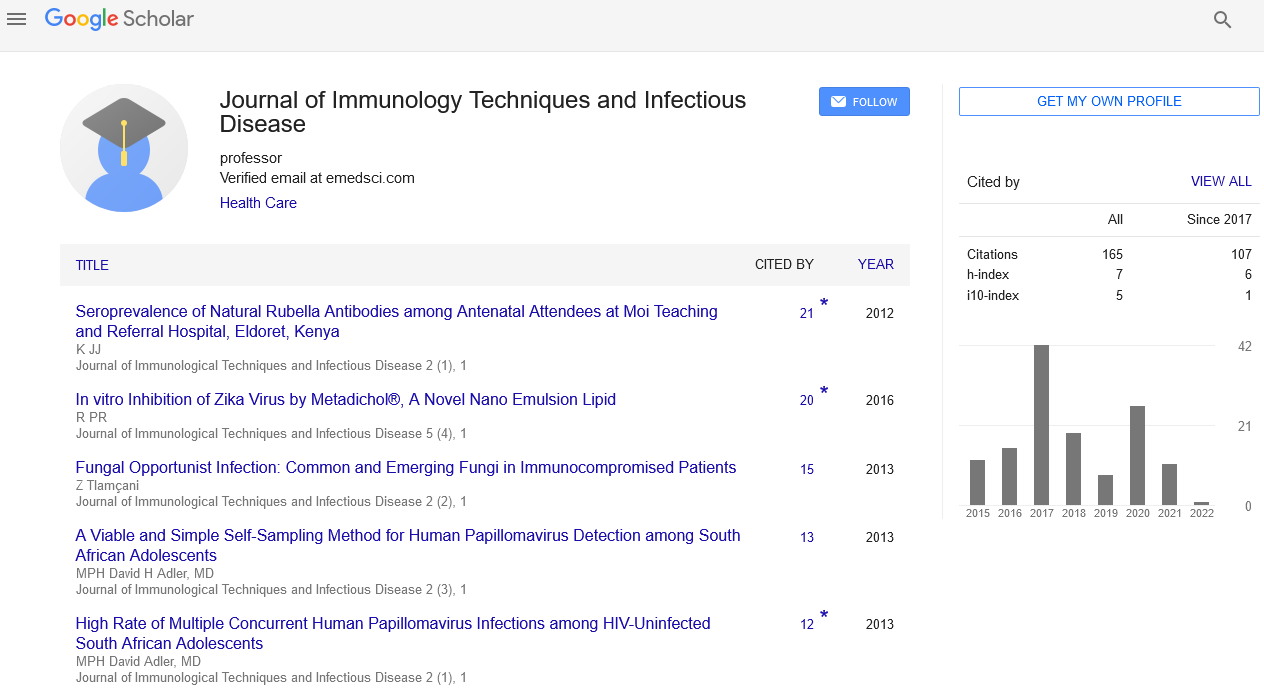Binding of hepatitis E virus RNA dependent RNA polymerase to the cis-acting regulatory elements in the HEV genome
Shakuntala Mahilkar and Kavita S. Lole
National Institute of Virology, India
: J Immunol Tech Infect Dis
Abstract
Hepatitis E, caused by Hepatitis E virus (HEV), is an important public-health concern in developing as well as developed countries.There is a need to understand virus biology because new aspects of virus infection are emerging such as zoonotic transmission and chronic cases in organ transplant and immune compromised patients also, it shows unexplained high mortality rate in pregnant women. Hepatitis E virus replication is still not completely understood due to lack of efficient cell culture system. The virus genome is positive sense ssRNA of about 7kb having a 5’ cap and a 3’poly a tail. The expression of its three open reading frames is achieved by producing genomic and subgenomic RNAs. The viral genome has 5’ and 3’ non-coding regions (NCR) with conserved stem loop structures known to be important during viral replication. Interaction between RNA dependent RNA polymerase (RdRp) and the viral cis-acting sequences is likely to be an important step in viral RNA replication. We analyzed binding affinity of viral RdRp to these cis-acting elements using Electrophoretic Mobility Shift Assay (EMSA). Purified recombinant RdRp protein, expressed in bacterial system, was incubated with putative regulatory elements in the HEV genome. While, binding affinity of the enzyme with these elements was determined by carrying out competition binding assays. The same assay was used for mapping of subgenomic promoter (sgP) region to find minimal binding region for efficient RdRp binding. The enzyme exhibited high binding affinity with the proposed sgP, between ORF1 and ORF2 junction region and 3’UTR with a poly A tail. While, affinity for the 5’NCR was comparatively less than the sgP and 3’NCR. A competition assay between the 3’NCR and sgP showed a super-shift suggesting RdRp to have either two separate binding motifs/ or co-operative binding with these two cis-acting elements. These studies give us a molecular insight for virus transcription and replication and provide targets for antiviral development.
Biography
Shakuntala Mahilkar is a senior research fellow at National Institute of Virology (NIV), University of Pune, Maharastra, India. Currently she is writing her Ph.D. thesis entitled “Identification and characterization of regulatory elements on Hepatitis E virus Genome” under the supervision of Dr Kavita S. Lole. My Ph.D and the work is to explore the Hepatitis E Virus (HEV) genome for the regulatory elements involved in replication and transcription. HEV is a single stranded positive sense RNA virus which utilizes RNA Dependent RNA Polymerase (RdRp) for its replication and transcription. Identification of binding region for RdRp will give us insight of how HEV maintain its replication as well as transcription and translation within a small genome, and also an idea about the virus life cycle. This study will further help in designing the antiviral therapies for HEV infection. Earlier in the year 2006-2007 she worked as a Junior Research Fellow at School of Biotechnology on the project entitled “Metabolic engineering of E. coli to remove the bottlenecks in recombinant protein expression” sponsored by Department of Biotechnology (DBT). She had Qualified All India Combined Entrance Test for admission in M.Sc. Biotechnology programme in 2003 conducted by the JNU, New Delhi, and completed her Masters in Biotechnology from Himachal Pradesh University, Shimla in the year 2005, during that period she did a project work on the topic “Studies on microbial tyrosinase and b-tyrosinase.” Also she completed winter training at National Institute of Plant Genome Research (NIPGR), New Delhi, on the topic “Cloning of WRKY gene from Oryza Sativa.”
E mail: shakuntalamahilkar@gmail.com
 Spanish
Spanish  Chinese
Chinese  Russian
Russian  German
German  French
French  Japanese
Japanese  Portuguese
Portuguese  Hindi
Hindi 
